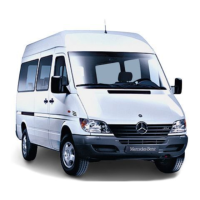Depending on thevehicle's equipment, theradar
sensorsare integrated behind thebumpers
and/or behind theradiator grill. Keep these parts
free of dirt, ice and slush (/ page274). Thesen‐
sorsmustnot be covered, forexample by bicycle
racks, overhanging loads or stickers.After acolli‐
sion, have thefunction of theradar sensors
checkedataqualified specialistworkshop as
damage(both visible or non-visible) mayhave
occurredtothe bumper or radiator trim.
Function of driving systems and driving
safetysystems
In this section, youwill find information aboutthe
following driving systems and driving safetysys‐
tems:
R
ABS (Anti-lock braking system)
(/ page138)
R
ASC (Acceleration Skid Control)
(/ page138)
R
BAS(Brake Assist System) (/ page138)
R
ESP
®
(Electronic Stability Program)
(/ page139)
R
EBD (Electronic Brakeforce Distribution)
(/ page140)
R
ActiveBrake Assist (/ page140)
R
Cruise control (/ page142)
R
ActiveDistance Assist DISTRONIC
(/ page 144)
R
Hill startassist
R
HOLDfunction (/ page146)
R
Parking AssistPARKTRONIC (/ page 146)
R
Rear viewcamera(/page148)
R
360° Camera(/page150)
R
ATTENTION ASSIST(/page152)
R
TrafficSign Assist (/ page153)
R
Blind SpotAssist (/ page155)
R
ActiveLaneKeeping Assist(/page158)
Functions of ABS (Anti-lockBraking System)
Observe theimportant safety guidelinesfor the
driving safetysystem.
ABS controls thebrake pressureincritical situa‐
tions:
R
thewheels areprevented from locking when
braking, e.g. during maximum full-stopbrak‐
ing or when thereisinsufficient tiretraction.
R
thesteerability of thevehicle in termsof
physical possibilities is ensured when brak‐
ing.
R
ABSisactivefromspeeds of approx.3mph
(5 km/h). On aslipperyroad surface, ABS
intervenes evenifyou onlybrake gently.
System limitations
If thereisamalfunction and theyellow ! ABS
warning lamplightsupcontinuouslyinthe instru‐
ment displayafter startingthe engine, ABS may
be impaired or inoperative.
If ABS intervenes, youwill feel apulsing in the
brakepedal. The pulsating brakepedal maybean
indication of hazardous road conditionsand func‐
tions as areminder to take extracarewhile driv‐
ing.
If ABS intervenes: keep thebrake pedal firmly
depressed until thebraking situation has passed.
To carry out maximum full-stopbraking:
depress thebrake pedal withfull force.
Function of BAS(BrakeAssistSystem)
&
WARNING Risk of an accident caused by
amalfunctioninBAS (BrakeAssist Sys‐
tem)
If BASismalfunctioning,the braking distance
in an emergency braking situation is
increased.
#
Depress thebrake pedal withfull force
in emergency braking situations. ABS
prevents thewheels from locking.
BASsupportsyou withadditional braking forcein
an emergency braking situation.
If youdepress thebrake pedal quickly, BASis
activated:
R
BASautomatically boosts thebraking forceof
thebrakes
R
BAScan shorten thebraking distance
R
ABS preventsthe wheels from locking
When yourelease thebrake pedal, thebrakes
function as usual again. BASisdeactivated.
Functions of ASR (Acceleration Skid Control)
ASR can neither reduce therisk of an accident
nor override thelawsofphysics if thedriverdoes
notpay attention when pulling away or accelerat‐
ing. ASR is onlyanaid. Alwaysadaptyour driving
138
Driving and parking

